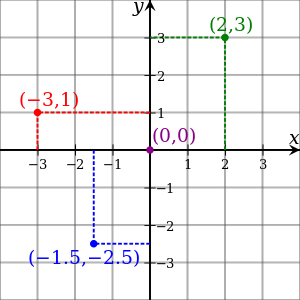Abscissa

In mathematics, an abscissa (/æbˈsɪs.ə/; plural abscissae or abscissæ or abscissas) is the perpendicular distance of a point from the vertical axis. Usually this is the horizontal coordinate of a point in a two-dimensional rectangular Cartesian coordinate system. The term can also refer to the horizontal axis (typically x-axis) of a two-dimensional graph (because that axis is used to define and measure the horizontal coordinates of points in the space). An ordered pair consists of two terms—the abscissa (horizontal, usually x) and the ordinate (vertical, usually y)—which define the location of a point in two-dimensional rectangular space.
In parametric equations
In a somewhat obsolete variant usage, the abscissa of a point may also refer to any number that describes the point's location along some path, e.g. the parameter of a parametric equation.[1] Used in this way, the abscissa can be thought of as a coordinate-geometry analog to the independent variable in a mathematical model or experiment (with any ordinates filling a role analogous to dependent variables).
Examples
- For the point (2, 3), 2 is called the abscissa and 3 the ordinate.
- For the point (-1.5, -2.5), −1.5 is called the abscissa and −2.5 the ordinate.
See also
- Ordinate
- Dependent and independent variables
- Function (mathematics)
- Relation (mathematics)
- Line chart
References
- ↑ Hedegaard, Rasmus; Weisstein, Eric W. "Abscissa". MathWorld--A Wolfram Web Resource. Retrieved 14 July 2013.
This article is based on material taken from the Free On-line Dictionary of Computing prior to 1 November 2008 and incorporated under the "relicensing" terms of the GFDL, version 1.3 or later.
External links
-
 The dictionary definition of abscissa at Wiktionary
The dictionary definition of abscissa at Wiktionary
